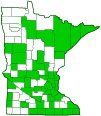white poplar
(Populus alba)
Conservation • Weed • Description • Habitat • Ecology • Use • Distribution • Taxonomy
Description |
||
White poplar is a fast-growing, short-lived, deciduous tree rising on a single trunk from a shallow, spreading root system. In Minnesota, mature trees are usually 40′ to 70′ tall and up to 24″ in diameter at breast height, though large individuals can reach 89′ in height and 78 ″ in diameter. It often has shoots (suckers) rising from the roots up to 100′ from the trunk, and sometimes forms extensive colonies. For this reason, it is sometimes considered a weed. The trunk is short, much branched, often crooked, and often forked near the base. When growing in a forest, the crown is thin and narrow. When in an open area, it is broad and rounded. The branches are stout, crooked, and spreading to ascending. The bark on young trees is smooth and greenish-white. After several years it is gray to grayish-brown with dark, conspicuous pores (lenticels). The lenticels are large, raised, corky, and distinctly diamond-shaped. On older trees the bark near the base is thick, dark gray, and rough, with longitudinal furrows and ridges. Young twigs are slender, greenish-gray, and densely covered with whitish-gray, felt-like hairs. They are round in cross section and have white pith. As they age they become hairless or nearly hairless. Terminal buds are ⅛″ to ⅜″ long, egg-shaped, and pointed. They are not resinous. They are densely covered with whitish-gray, felt-like hairs. Lateral buds are similar but smaller. Two types of leaves are produced: early (preformed) leaves; and late (neoformed) leaves. Preformed leaves overwinter in the bud and are fully formed or almost fully formed before the buds burst in the spring. They are the first leaves to mature in the spring. Neoformed leaves are all of the subsequent leaves produced on long shoots. They are formed in the same season that they emerge. All leaves are deciduous and alternate. The leaf stalks (petioles) are 1″ to 2 3 ⁄16″ long, shorter than the leaf blades, and are more or less round in cross section, not flattened. They are densely covered with white, woolly hairs. There are no conspicuous glands on the petiole. There is sometimes a pair of cup-shaped glands at or near the base of the leaf blade. Preformed leaf blades are egg-shaped, unlobed, 1½″ to 2⅜″ long, and slightly less wide. They taper or are angled to a blunt point at the tip, and are rounded or slightly heart-shaped at the base. The upper surface is dark green and shiny, densely hairy at first, becoming thinly hairy just along the main veins when mature. The lower surface is densely covered with persistent, white, felt-like hairs. The margins are minutely hairy and have 3 to 8 broad, coarse teeth or scallops per side as well as scattered small teeth. There is no thin yellow or translucent line or band along the margin. Neoformed leaves are larger, 2⅜″ to 4¾″ long, and are palmately lobed with 3 or 5 lobes. Their shape is similar to a maple leaf. The margins are irregularly finely toothed and scalloped. They are otherwise similar to preformed leaves. The leaves turn reddish-yellow In autumn. Male (staminate) and female (pistillate) flowers are borne on separate trees. They appear before the leaves in March to May. Both male and female flowers are borne in narrow, crowded, short-stalked or almost stalkless clusters (catkins). The catkins emerge from lateral buds on 2nd year twigs. Staminate catkins are 1 3 ⁄16″ to 2⅜″ long and pendulous, pistillate catkins 2″ to 4″ long, arched, and drooping. Each staminate flower consists of a cup-like disk and 6 to 12 stamens, and is subtended by a single, nearly oval, modified leaf (bract). The stamens have anthers that turn bright red before shedding pollen. The bract is toothed, not lobed, and has long, silky hairs along the margins, at least toward the tip. Each pistillate flower consists of a disk, a naked superior ovary, and a single style, and is subtended by a single bract. The style is branched nearly to the base and has a slender stigma at each tip The fruit is a narrowly egg-shaped, hairless, ⅛″ to 3 ⁄16″ long, 2-valved capsule. They are green at first, turning brown at maturity. The seeds are about 1 ⁄16″ long and are surrounded by long silky hairs that are attached at the base of the seed. They are released in late spring to early summer and are dispersed by wind. |
||
Height |
||
40′ to 70′ |
||
Record |
||
No records kept for non-native trees. |
||
Flower Color |
||
Gray to reddish |
||
Similar Species |
||
Habitat |
||
Moist. Upland forests, stream banks, roadsides, field borders, and old homesites. Full or partial sun; shade intolerant. Well drained soil. |
||
Ecology |
||
Flowering |
||
March to May |
||
Pests and Diseases |
||
|
||
Use |
||
|
||
Distribution |
||||
|
Sources |
|||
| 7/9/2023 | ||||
Nativity |
||||
Native to Europe, Asia, North Africa, and the Canary Islands. Introduced into North America in 1748. Widely cultivated. Sometimes escapes cultivation. Widely naturalized in the United States and southern Canada. |
||||
Occurrence |
||||
Uncommon in Minnesota |
||||
Taxonomy |
|||
| Kingdom | Plantae (Plants) | ||
| Division | Tracheophyta (Vascular Plants) | ||
| Subdivision | Spermatophytina (Seed Plants) | ||
| Class | Magnoliopsida (Dicots) | ||
Order |
Malpighiales (Nances, Willows, and Allies) | ||
Family |
Salicaceae (Willow) | ||
| Subfamily | Salicoideae | ||
| Tribe | Saliceae | ||
| Genus | Populus (poplars, cottonwoods, and aspens) | ||
| Section | Populus (aspens and allies) | ||
Synonyms |
|||
Populus alba var. bolleana Populus alba var. nivea Populus alba var. pyramidalis |
|||
Common Names |
|||
abele European white poplar silver poplar silverleaf poplar white poplar |
|||
Glossary
Bract
Modified leaf at the base of a flower stalk, flower cluster, or inflorescence.
Catkin
A slim, cylindrical, drooping cluster of many flowers. The flowers have no petals and are either male or female but not both.
Lenticel
A corky, round or stripe-like, usually raised, pore-like opening in bark that allows for gas exchange.
Petiole
On plants: The stalk of a leaf blade or a compound leaf that attaches it to the stem. On ants and wasps: The constricted first one or two segments of the rear part of the body.
Pistillate
Referring to a flower that has a female reproductive organ (pistil) but does not have male reproductive organs (stamens).
Pith
The spongy cells in the center of the stem.
Staminate
Referring to a flower that has a male reproductive organs (stamens) but does not have a female reproductive organ (pistil).
Sucker
A basal shoot rising from the roots or from a bud at the base of a shrub or tree.
Visitor Photos |
|||||
Share your photo of this plant. |
|||||
| This button not working for you? Simply email us at info@MinnesotaSeasons.com. Attach one or more photos and, if you like, a caption. |
|||||
Randy |
|||||
Form of mature white poplar, South Central Minnesota, December 2017 |
|||||
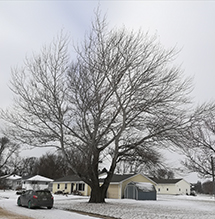 |
|||||
White poplar, near MN/IA border, 2016 |
|||||
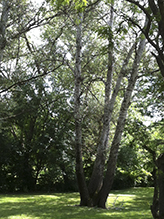 |
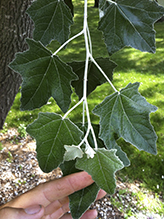 |
||||
MinnesotaSeasons.com Photos |
|||||
Tree |
|||||
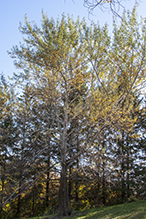 |
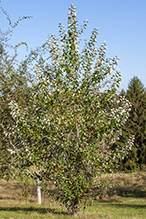 |
||||
Branch |
|||||
 |
|||||
Leaves |
|||||
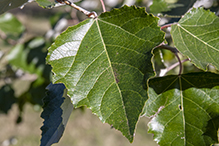 |
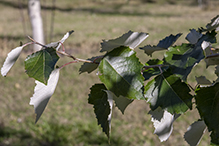 |
||||
Leaf Underside |
|||||
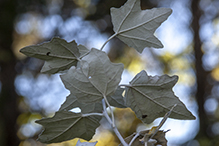 |
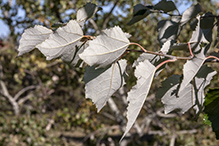 |
||||
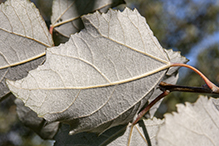 |
|||||
New Growth |
|||||
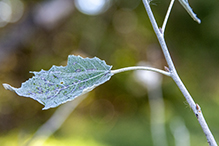 |
|||||

Slideshows |
||
| Populus alba Matt Lavin |
||
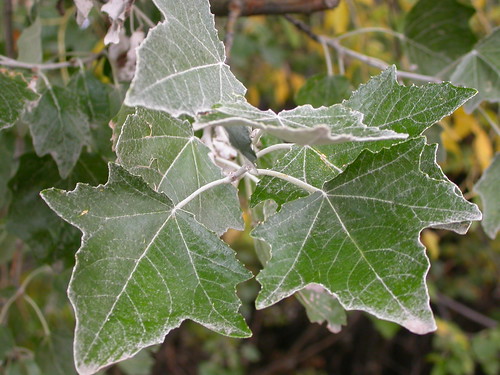
|
||
About
Introduced tree 5-20 m tall, leaves distinctively with white tomentose undersurfaces, often escaping cultivation along riparian corridors. Although the leaves may look maple-like (palmately lobed), Populus does not have opposite branching. |
||
| Populus alba Blake C. Willson |
||
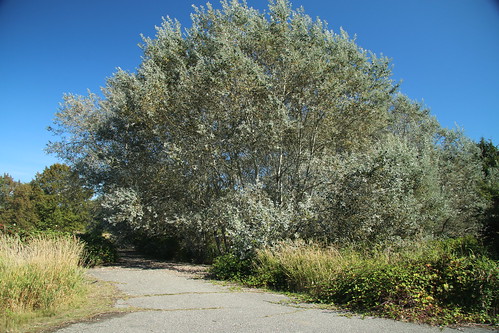
|
||
About
White Poplar |
||

Visitor Videos |
|||
Share your video of this plant. |
|||
| This button not working for you? Simply email us at info@MinnesotaSeasons.com. Attach a video, a YouTube link, or a cloud storage link. |
|||
Other Videos |
|||
| Trees with Don Leopold - white poplar ESFTV |
|||
About
Published on Jun 27, 2012 |
|||
| Educational videos on nature (White poplar - tree)- July 2017 Terrence Pickles |
|||
About
Published on Jul 18, 2017 There isn't much White Poplar around Exeter from what I've seen. The few that I have found are located in the Sowton industrial estate of Exeter, UK. === White poplar is a deciduous broadleaf tree native to central and southern Europe, though it is naturalised in the UK. White poplar can grow to 20m. It is the whitest tree in the landscape, and from a distance it can appear to be covered in snow. The bark is pale grey with lines of black diamond-shaped pores, called lenticels. Twigs are white, and young twigs have a covering of dense white hair that last until their second year. It is native to Morocco and the Iberian Peninsula, white poplar grows in moist conditions, often by watersides. === This species is introduced and widely planted in parks and gardens, mainly for the beauty of its foliage. It flourishes in polluted air or near the sea. Male catkins, 4-7 cm long, and female catkins 2-5 cm long, appear on separate trees (dioecious) in February and March, well before the leaves. The male catkins have purple anthers, whilst the females have greenish stigmas. Male trees are rare, so fertile catkins and seed are infrequent. Goat Moth caterpillars tunnel under the bark and damage the timber below. It is seldom cultivated for timber because other species of poplar grow more quickly. It is a native from Western Europe to Central Asia introduced to Britain from Holland in the 16th century === Scientific classification |
|||

Visitor Sightings |
|||||
Report a sighting of this plant. |
|||||
| This button not working for you? Simply email us at info@MinnesotaSeasons.com. Be sure to include a location. |
|||||
| Randy December 2017 |
Location: South Central Minnesota Form of mature white poplar |
 |
|||
| Randy 2016 |
Location: near MN/IA border |
 |
|||
MinnesotaSeasons.com Sightings |
|||||

Created: 12/9/2017
Last Updated:
